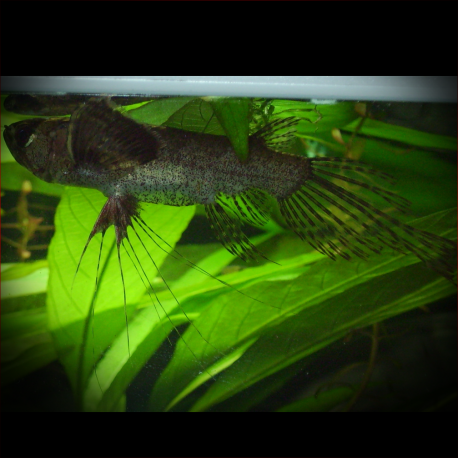More info
Datasheet
| Minimum Tank Size | 80 litres / 21.13 US gallons |
| Maximum Size | 12.0cm / 4.72inches |
| Temperature | 23°C / 73.40°F - 30°C / 86.00°F |
| Hardness | 5-15ºdH |
| pH | 6.0-7.5 |
General Description
The African Butterfly Fish, scientifically known as Pantodon buchholzi, derives its common name from the butterfly-like appearance it displays when viewed from above. Its large pectoral fins resemble the wings of a butterfly and aid in both camouflage and powerful jumps. Belonging to the Osteoglossiformes order, this species is the sole member of the Pantodontidae family and the Pantodon genus.
Aquarium Setup
For optimal care, the African Butterfly Fish thrives in slightly soft, acidic water with minimal water movement. An 80-liter tank or larger with a tightly fitting lid is recommended, along with a dimly-lit environment and floating plants to provide cover and replicate its natural habitat. The aquarium décor below the surface is flexible and can accommodate tankmates.
Behaviour
While generally peaceful, the butterfly fish can display aggression towards fin-nipping species and target smaller fish that fit in its mouth. It may also exhibit territorial behavior towards other surface-dwelling species. Within the species, aggression can occur, so it is advisable to keep them in small groups in spacious tanks to reduce conflicts.
Feeding and Diet
Being primarily insectivores, the African Butterfly Fish thrives on a varied diet consisting of live and frozen foods like bloodworms, brine shrimp, and small mealworms. It shows a particular preference for live insects such as spiders and flies, feeding exclusively on the water's surface. While they may accept flake food, it should not be the primary diet to ensure proper nutrition.
Reproduction & Dimorphism
Breeding the African Butterfly Fish can be challenging but achievable with careful setup and attention. They are egg-scatterers and require a spacious tank with floating plants for spawning. Spawning involves considerable male chasing of the female, with the eggs floating to the surface for incubation. Sexing can be determined by the shape of the anal fin, which is straight in females and convex in males.
Habitat and Distribution
Originating from regions like the Republic of Congo, Cameroon, and Nigeria, the African Butterfly Fish inhabits slow-moving waters in creeks, lakes, and swamps. Its natural habitat typically includes dense aquatic or overhanging vegetation, providing cover for this surface-dwelling species.

